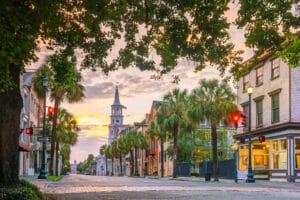
Soul cities: Charleston, South Carolina
IQ
- 4 Min Read
In order to offer transparency into how our stories are produced and to teach our readers about the importance of media literacy online, the editorial team provides a quick self-rating of the integrity of the articles and the facts presented against the following IQ metrics.
- Published on September 20, 2022
- Last Updated March 10, 2023
- In Guest Writers
Writer K. Anoa Monsho explores what she calls America's great Soul Cities, those places that are synonymous with African American and Black culture.
I call them Soul Cities—New Orleans, Birmingham, Jackson, Atlanta and Charleston come immediately to mind—places that are so steeped in an African American cultural aesthetic that they are sacred ground. These cities, towns and spaces are peppered throughout the nation (I see you Harlem, Detroit, Chicago, Milwaukee, Oakland!) and spiced with a Southern aesthetic.
Charleston is the nexus of a richGullah Geechee cultural corridor that stretches along the low-country coastal areas and sea islands of Georgia, the Carolinas and Florida. The folk who live in and around these waterways have roots that plunge deep, retaining West African traditions in the purest forms known in the U.S. You have only to experience Gullah cuisine, culture, crafts, language and art to intuit a visceral connection to the ancestors from the West African coast and interior.
Sewing sweetgrass, rooted in the past
“My mother taught me how to weave sweetgrass when I was six years old, and her mother taught her,” said Vaness Robinson of the intricate functional art baskets that are the best-known of Gullah Geechee crafts. “I know it goes back further than six generations, all the way back to Sierra Leone.” She and her family are one of about 50 Gullah artisans who sell their work in the historic City Market in downtown Charleston.
“It’s basically the same way of sewing sweetgrass down through the generations and different families have their different patterns,” she said. “I taught my daughter and now we’re teaching my four-year-old granddaughter.” Robinson is bemused by people who buy sweetgrass baskets only to admire them.
“These baskets are made to be functional, not just as art,” Robinson said. “They are sturdy. We use them as clothes hampers, fruit and bread baskets, drinking glass holders, everything you can use a basket for in the home, they’re for everyday use.”
‘Daughters of the Dust’
My first visual encounter with Gullah culture was the movie Daughters of the Dust in 1991. Directed by visionary filmmaker Julie Dash, Daughters was the first feature-length film directed by a Black woman to be released in theaters across the nation. In it, she weaves the stories of three generations of Gullah women into a lush and gorgeous epic that highlights the tension between holding fast to tradition and finding ways to merge tradition with the inexorable future. After Hollywood failed to promote it, the movie faded from memory, until Beyonce’s Lemonade. The film has since been re-released and is currently available on various streaming sources.
How lifegiving the water is
Internationally renowned artist Jonathan Green is a powerful spokesperson for Gullah art and culture. He is wildly prolific, having sold more than 3,800 original works of art to collectors across the globe. His painting “Escorting Ruth” holds a place of honor in our home. In it, Jonathan’s mother Ruth, heavily pregnant with him, is flanked by her two sisters as two boatmen ferry them across the marsh to a woman—the midwife—waiting on a pier. The women are calm, as is the cerulean water, and garbed in vibrantly hued dresses that would surely billow magically in the wind. Each wears a wide-brimmed sun hat, the sisters carefully attend to Ruth. She is wearing delicately laced gloves; no one wears shoes. When we met to chat, I joked that I’ve known him since he was a fetus.
“I have always been a feminist,” Green explained. “I think it came from my mother. When she had children, all of her girlfriends were having children at the same time so they were always doing things together. I was raised by that community of women, including my grandmother.”
Green explained that he was born with a caul, or a veil, a rare event that many cultures consider to have spiritual significance. In Green’s community, a child born with a veil was considered to have special powers, including protection from drowning.
“What a lot of our people don’t understand is how lifegiving the water is. We [Gullah Geechees] are a maritime people.” Green said.
It inspires art, provides food, and creates culture. “Our value comes from our generational collectiveness,” he said. “Anyone who is part of the African diaspora should be able to connect over the many things we have in common.”
Green is as much activist as artist, and is involved in nearly every aspect of life in Charleston. He can frequently be found holding court at his favorite spot, Charleston Place Hotel, talking about the city’s long-anticipated International African American Museum or accepting praise for “Requiem for Rice,” a dramatic musical performance honoring the enslaved Africans of the Low Country, which is still a topic of conversation in the city.
About that Plantation Life
“I think African Americans who come to Charleston should visit Middleton Place Plantation,” Green said, making a counterpoint to the suggestion that it might be painful. “We need to understand the value of worshipping the grounds of the plantations. Our ancestors built them; our ancestors are buried there. They are a monument to African ingenuity, sustainability and resilience. We can celebrate our ancestors’ achievements, and bemoan their pain. Their suffering allowed us to survive and thrive.”
In Charleston, as in all Soul Cities, Black folks’ works of stunning beauty and invention are interwoven and rooted in exploitation and pain. Those works are the museums and mausoleums that lie at the intersections of all of African American history.
K. Anoa Monsho is a creative writer, journalist, multi-media storyteller, director, and editor with a strong interest in travel, Black health and wellness, and cultural arts. She believes in the life-giving, life-healing power of sharing true stories and that travel begins in the imagination.
This story was created by Detour, a journalism brand focused on the best stories in Black travel, in partnership with McClatchy’s The Charlotte Observer and Miami Herald. Detour’s approach to travel and storytelling seeks to tell previously under-reported or ignored narratives by shifting away from the customary routes framed in Eurocentrism. The detour team is made up of an A-list of award-winning journalists, writers, historians, photographers, illustrators and filmmakers.








